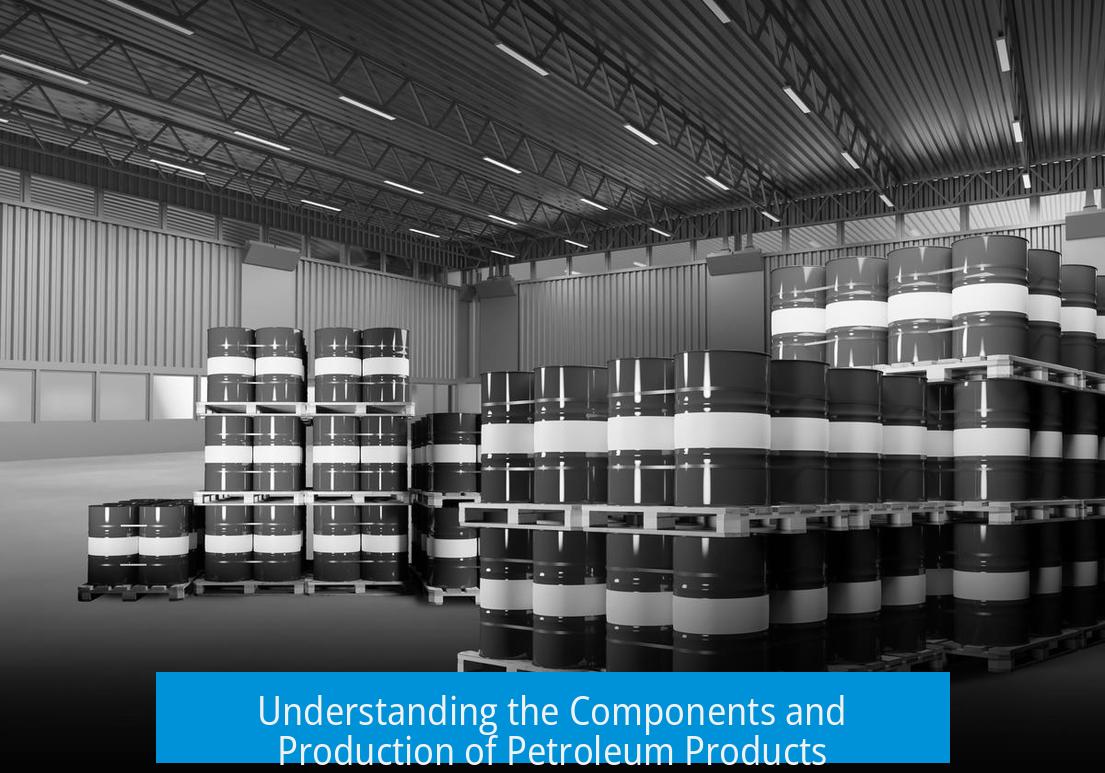What Are Petroleum Products Made Out Of?
Petroleum products are made primarily from complex mixtures of hydrocarbons derived from crude oil. These hydrocarbons range from light gases to heavy molecules. Their composition varies greatly depending on the crude source and refining processes involved.
1. Composition of Petroleum Products
1.1 Hydrocarbon Chains and Impurities
Petroleum products consist of hydrocarbon chains with varying lengths and structures. These chains are molecules made of carbon and hydrogen atoms. The crude oil itself forms from ancient organic matter subjected to heat and pressure over millions of years. This process yields a mixture of organic molecules with no strict uniformity. The final petroleum products contain a spectrum of carbon atoms, showing a range rather than fixed molecular formulas. Impurities often include sulfur-, nitrogen-, and oxygen-containing molecules.
1.2 Types of Hydrocarbons Present
The hydrocarbons in petroleum mainly fall into two categories: saturated and unsaturated molecules. Saturated hydrocarbons, or alkanes, contain single bonds only. Unsaturated hydrocarbons, such as alkenes, include one or more double bonds. Additionally, petroleum products sometimes contain oxygenated compounds, like alcohols, and a variety of isomers—molecules with the same formula but different structures. These variations impact their chemical behavior and physical properties.
1.3 Variability in Composition
The exact composition of petroleum products hinges on the crude oil source. Crude oil from different regions such as Texas or the North Sea varies. Some crudes are “light,” rich in smaller hydrocarbon chains and gaseous components. Others are “heavy,” with longer chains and increased impurities like nitrogen and sulfur. This variability mandates tailored refining methods to produce market-ready products.
2. Production and Processing of Petroleum Products
2.1 Fractional Distillation
Refineries extract usable products through fractional distillation, which separates crude oil into fractions based on boiling points. Each fraction contains molecules that boil within a specific temperature range. Distillation typically separates crude into 8 to 10 fractions such as liquefied petroleum gas (LPG), gasoline, diesel, kerosene, lubricants, waxes, and bitumen. Gasoline and diesel are two well-known fractions derived from this method.
2.2 Main Refining Processes
Primary refining steps include atmospheric distillation, where crude oil is heated and vaporized under normal pressure, and vacuum distillation, which operates under lowered pressure to target heavier components. Further processes address impurity removal and molecular restructuring. Hydrodesulfurization (HDS) and the Clauss process eliminate sulfur compounds. Reforming and cracking processes alter hydrocarbon structures:
- Steam cracking
- Thermal cracking
- Catalytic cracking
These methods break down heavier fractions to produce lighter, more valuable products or improve specific qualities like octane number.
2.3 Typical Fractions by Boiling Point or Carbon Chain Length
Fractions correspond to carbon chain lengths and boiling ranges roughly as follows:
| Fraction | Carbon Chain Length | Use |
|---|---|---|
| LPG (Liquefied Petroleum Gas) | C3-C4 | Heating, cooking fuel |
| Gasoline/Naphtha | C5-C12 | Fuel for vehicles, chemical feedstock |
| Diesel/Fuel Oil | C12-C20 | Vehicle fuel, industrial heating |
| Kerosene | C10-C16 | Jet fuel, lighting |
| Lubricants | C20-C50 | Machinery lubrication |
| Waxes | Higher carbon chains | Candles, coatings |
| Bitumen | Very high carbon chains | Road paving, roofing |
The composition of fractions can vary. For example, straight-run naphtha has more alkanes than cracked naphtha from vacuum gas oil.
3. Variation and Specifications of Final Products
3.1 No Fixed Composition Rules for Final Products
The final petroleum products do not adhere to strict compositional rules. Refiners aim to produce specifications, such as gasoline standards, as economically as possible. This often involves blending multiple sources such as crude oil from different countries, by-products from various refining units, and additives. The goal is to meet quality standards contingent on market demands and regulations.
3.2 Variability by Supply Chain and Pricing
Feedstock sourcing changes with global market prices and regional availability. A refiner might adjust inputs several times within months to optimize costs. This flexibility influences the molecular composition of final products. The same approach applies to processing other petroleum-derived commodities.
3.3 Differences Even Within Same Country or Brand
Even within national boundaries or among brands, petroleum products vary. Companies customize specifications, especially gasoline, to suit their performance needs. For instance, different brands may vary additive packages to achieve targeted octane ratings. Octane number measures a gasoline’s resistance to premature combustion, a critical factor for engine performance.
Key Takeaways
- Petroleum products are mainly hydrocarbons, including alkanes and alkenes, with various impurities depending on the crude source.
- Crude oil composition varies by geographical origin and contains molecules of different carbon chain lengths.
- Fractional distillation separates crude oil into distinct fractions based on boiling points, yielding products like gasoline, diesel, and lubricants.
- Refining processes such as cracking and desulfurization modify fractions to meet product specifications.
- Final petroleum products composition varies over time due to supply, price, and refinery tactics; no fixed formula exists.
- Different brands produce gasoline with varying additives to control performance parameters like octane rating.
What basic components make up petroleum products?
Petroleum products mainly consist of hydrocarbon chains. These include alkanes and sometimes alkenes, plus various impurities. The exact mix depends on the original crude oil source.
How do refineries separate crude oil into different products?
Crude oil is separated through fractional distillation. This process divides the oil by boiling points into fractions like gasoline, diesel, kerosene, and lubricants. Each fraction contains chemicals with similar properties.
Why do petroleum products vary between different regions or brands?
Crude oil differs depending on its source, which affects the final products. Refineries also adjust mixes based on cost and regulations. Even gasoline from the same country or brand can have different additives and octane levels.
What refining processes alter the composition of petroleum products?
After distillation, processes like catalytic cracking and hydrodesulfurization change the chemical makeup of fractions. These steps improve quality and meet environmental standards.
Are petroleum products made from a fixed set of substances?
No. There’s no strict rule for the exact composition of final petroleum products. Refiners often use different feedstocks to produce similar products while aiming to meet specifications at minimal cost.





Leave a Comment